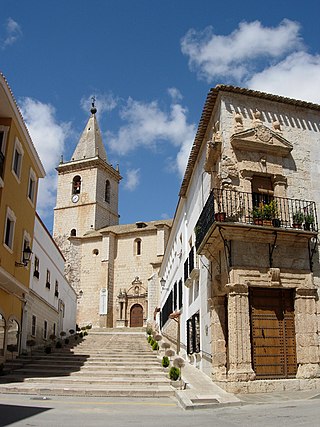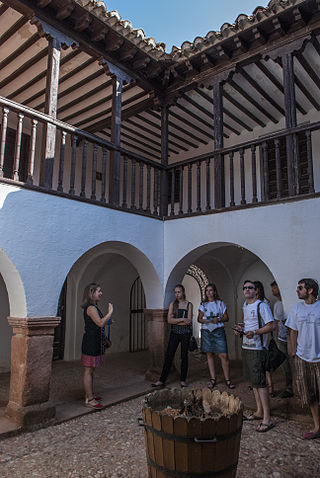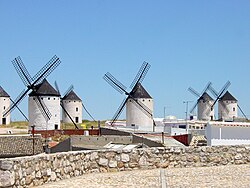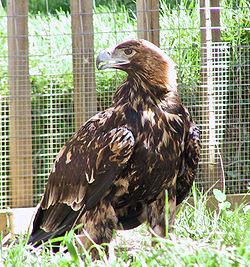
Don Quixote, the full title being The Ingenious Gentleman Don Quixote of La Mancha, is a Spanish novel by Miguel de Cervantes. It was originally published in two parts, in 1605 and 1615. Considered a founding work of Western literature, it is often said to be the first modern novel. The novel has been labelled by many well-known authors as the "best book of all time" and the "best and most central work in world literature". Don Quixote is also one of the most-translated books in the world and one of the best-selling novels of all time.

Manchego is a cheese made in the La Mancha region of Spain from the milk of sheep of the Manchega breed. It is aged between 60 days and 2 years.

Castilla–La Mancha is an autonomous community of Spain. Comprising the provinces of Albacete, Ciudad Real, Cuenca, Guadalajara and Toledo, it was created in 1982. The government headquarters are in Toledo, which is the capital de facto.

Albacete is a province of central Spain, in the southern part of the autonomous community of Castile–La Mancha. As of 2012, Albacete had a population of 402,837 people. Its capital city, also called Albacete, is 262 kilometres (163 mi) by road southeast of Madrid.

The province of Ciudad Real is a province in the southwestern part of the autonomous community of Castile-La Mancha, Spain. It is bordered by the provinces of Cuenca, Albacete, Jaén, Córdoba, Badajoz, and Toledo. It is partly located in the old natural region of La Mancha. Its capital is Ciudad Real. It is the third largest province by area in all of Spain, after Cáceres and Badajoz. The historic comarca Campo de Calatrava is located in the center of the province.

Ciudad Real is a municipality of Spain located in the autonomous community of Castile–La Mancha, capital of the province of Ciudad Real. It is the 5th most populated municipality in the region.

Albacete is a city and municipality in the Spanish autonomous community of Castilla–La Mancha, and capital of the province of Albacete.

Manchego cuisine refers to the typical dishes and ingredients in the cuisine of the Castilla–La Mancha region of Spain. These include pisto, gazpacho manchego, Manchego cheese, the white wine of La Mancha, and the red wine from Valdepeñas (DO).

La Roda is a Spanish municipality located in the Province of Albacete, within the autonomous community of Castilla-La Mancha. It is situated along the A-31 highway and has a population of 15,527 inhabitants. The town is known for its pastry known as miguelitos. It is part of the La Mancha region of Albacete.

Villarrobledo is a Spanish city and municipality in the province of Albacete, part of the autonomous community of Castilla-La Mancha. It's better known for having the world's largest area covered by vineyards as well as the world's greatest production of La Mancha wine, called in Spanish Denominación de Origen. Also, it is an important center of Manchego cheese production and export and has other important industries like metallurgy and transportation.

Villanueva de los Infantes is a municipality in the province of Ciudad Real, Castilla–La Mancha, Spain. It has a population of 5727 people.

Mancheguian regionalism is a minoritarian political current in Spain that proposes the existence of a differentiated historical region in La Mancha with its proper legal entity, against the Pancastilian thesis that considers Castile as a unique nation or region. Very minority currents inside the Mancheguian Regionalism supports to go beyond the regionalism by a total rupture with Spain.

Consuegra is a municipality located in the province of Toledo, Castile-La Mancha, Spain. In 2018, the municipality had a population of 10,098 inhabitants. It is 80 km from Ciudad Real and 60 km from Toledo. Consuegra is located in La Mancha region, famous for its extensive dry plains, vineyards and historical constructions such as windmills.

Don Quixote or Don Quixote de la Mancha is the first sound film version in Spanish of the great classic novel by Miguel de Cervantes Saavedra. It was directed and adapted by Rafael Gil and released in 1947. A huge undertaking for Spanish cinema in its day, it was the longest film version of the novel up to that time, and very likely the most faithful, reverently following the book in its dialogue and order of episodes, unlike G.W. Pabst's 1933 version and the later Russian film version, which scrambled up the order of the adventures as many film versions do. Characters such as Cardenio, Dorotea, and Don Fernando, which are usually omitted because their respective subplots have little to do with the main body of the novel, were kept in this film.

The University of Castilla–La Mancha is a public Spanish university. It offers courses in the cities of Albacete, Ciudad Real, Cuenca, Toledo, Almadén and Talavera de la Reina. This university was recognised by law on 30 June 1982, and began to operate three years later.

Campo de Montiel is a comarca in Castile-La Mancha, Spain.
El Socialista Manchego was a weekly newspaper published from Alcázar de Cervantes, Spain from 1932 to 1938. It was published by the local branches of Spanish Socialist Workers' Party and Unión General de Trabajadores. Amongst the directors of El Socialista Manchego were Teodoro Vizcaino, Manuel Andújar Vela and Francisco Fernández. El Socialista Manchego disappeared in late 1938.
Ricardo de Pedraza Losa is a vision impaired B1/T11 Spanish Paralympic track and field competitor. He represented Spain at the 2012 Summer Paralympics, finishing eleventh in the 5,000 meter event. He has held several Spanish national records in long-distance events.






















